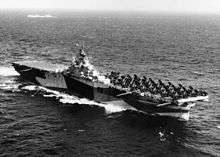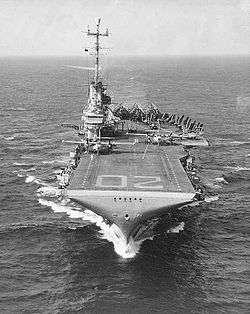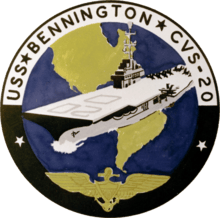USS Bennington (CV-20)
 USS Bennington (CVS-20) as an ASW-carrier, 1965 | |
| History | |
|---|---|
| Name: | USS Bennington |
| Namesake: | Battle of Bennington, 1777 |
| Ordered: | 15 December 1941 |
| Builder: | New York Naval Shipyard |
| Laid down: | 15 December 1942 |
| Launched: | 28 February 1944 |
| Commissioned: | 6 August 1944 |
| Decommissioned: | 8 November 1946 |
| Recommissioned: | 13 November 1952 |
| Decommissioned: | 15 January 1970 |
| Reclassified: |
|
| Struck: | 20 September 1989 |
| Fate: | Scrapped in 1994 |
| General characteristics | |
| Class and type: | Essex-class aircraft carrier |
| Displacement: |
|
| Length: |
|
| Beam: |
|
| Draft: |
|
| Propulsion: |
|
| Speed: | 33 knots (61 km/h) |
| Range: | 20,000 nautical miles (37,000 km) at 15 knots (28 km/h) |
| Complement: |
|
| Armament: |
|
| Armor: |
|
| Aircraft carried: |
|
USS Bennington (CV/CVA/CVS-20) was one of 24 Essex-class aircraft carriers built during World War II for the United States Navy. The ship was the second US Navy ship to bear the name, and was named for the Revolutionary War Battle of Bennington (Vermont). Bennington was commissioned in August 1944, and served in several of the later campaigns in the Pacific Theater of Operations, earning three battle stars. Decommissioned shortly after the end of the war, she was modernized and recommissioned in the early 1950s as an attack carrier (CVA), and then eventually became an Antisubmarine Aircraft Carrier (CVS). In her second career, she spent most of her time in the Pacific, earning five battle stars for action during the Vietnam War. She served as the recovery ship for the Apollo 4 space mission.
She was decommissioned in 1970, and sold to be scrapped in India in 1994.
Construction and commissioning
The ship was laid down on 15 December 1942 by the New York Navy Yard, and launched on 28 February 1944, sponsored by Mrs. Melvin J. Maas, wife of Congressman Maas of Minnesota. Bennington was commissioned on 6 August 1944, with Captain J. B. Sykes in command.
World War II

On 15 December, Bennington got underway from New York and transited the Panama Canal on the 21st. The carrier arrived at Pearl Harbor on 8 January 1945 and then proceeded to Ulithi Atoll, Caroline Islands, where she joined Task Group 58.1 on 8 February. Operating out of Ulithi, she took part in the strikes against the Japanese home islands (16 – 17 February and 25 February), Volcano Islands (18 February – 4 March), Okinawa (1 March), and the raids in support of the Okinawa campaign (18 March – 11 June). On 7 April, Bennington's planes participated in the attacks on the Japanese task force moving through the East China Sea toward Okinawa, which resulted in the sinking of the battleship Yamato, light cruiser Yahagi, and four destroyers. On 5 June, the carrier was damaged by a typhoon off Okinawa and retired to Leyte for repairs, arriving on 12 June. Her repairs completed, Bennington left Leyte on 1 July, and from 10 July – 15 August took part in the aerial raids on the Japanese home islands.
She continued operations in the western Pacific, supporting the occupation of Japan until 21 October. On 2 September, her planes participated in the mass flight over Missouri and Tokyo during the surrender ceremonies. Bennington arrived at San Francisco on 7 November, and early in March 1946 transited the Panama Canal en route to Norfolk, Virginia. Following pre-inactivation overhaul, she went out of commission in reserve at Norfolk on 8 November 1946.
Post-war
_underway_circa_1954.jpg)
The carrier began modernization at New York Naval Shipyard on 30 October 1950 and was recommissioned as CVA-20 on 13 November 1952. In this period, Bennington was the recipient of over 11 million man-hours during her SCB-27A conversion. Her deck was extended 43 ft (13 m) in length and was widened by 8 ft (2.4 m). The point was to modernize the ship to be able to launch jet aircraft. She also had the 5 in (130 mm) guns removed from the flight deck, which were replaced by smaller 3 in (76 mm) guns.

On 13 November, Captain David. B. Young took command of Bennington in a ceremony attended by more than 1,400, including the Secretary of the Navy Dan A. Kimball and Rear Admiral Roscoe H. Hillenkoetter who said the Bennington was "the most modern carrier in our fleet today."
Marine Air Group 14 (MAG-14), under the command of Colonel W.R. Campbell, USMC reported for duty on Bennington on 13 February 1953, and Bennington set off for the waters off Florida to conduct carrier qualifications. The first trap was made on Bennington since her recommissioning by Lieutenant Colonel T.W. Furlow in his AD Skyraider. Furlow was the commanding officer of Marine Attack Squadron 211 (VMA-211). The first jet aircraft to land on Bennington occurred on 18 February by Major Carl E. Schmitt in an F9F-5 Cougar. When the qualifications were over, Bennington headed for Guantanamo Bay Naval Base where she underwent 11 weeks of shakedown training.
Her shakedown lasted until May 1953, when she returned to Norfolk for final fleet preparations. On 27 April, a downcomer tube in Boiler Room One slipped loose which caused an explosion that killed 11 men, and seriously wounded four others. From 14 May 1953 – 27 May 1954, she operated along the eastern seaboard; made a midshipman cruise to Halifax, Nova Scotia; and a cruise in the Mediterranean.
Catapult explosion
At 06:11 on 26 May 1954, while cruising off Narragansett Bay, the fluid in one of her catapults leaked out and was detonated by the flames of a jet causing the forward part of the flight deck to explode, setting off a series of secondary explosions which killed 103 crewmen, predominantly among the senior NCO's of the crew and injured 201 others.[1] Bennington proceeded under her own power to Naval Air Station Quonset Point, Rhode Island, to land her injured. This tragedy caused the Navy to switch from hydraulic catapults to steam catapults for launching aircraft. A monument to the sailors who died in this tragic event was erected near the southwest corner of Fort Adams State Park in Newport, Rhode Island.
Moving to New York Naval Shipyard for repairs, she was completely rebuilt from 12 June 1954 – 19 March 1955. On 22 April, the Secretary of the Navy came aboard and presented medals and letters of commendation to 178 of her crew in recognition of their heroism on 26 May 1954. As of 1 August 1955, she was part of Carrier Division 2, along with Lake Champlain.[2] Bennington returned to operations with the United States Atlantic Fleet (including a two-month shake-down cruise to Guantanamo Bay with ATG-201) until departing Mayport, Florida for the Pacific on 8 September. She steamed by way of Cape Horn and arrived at San Diego one month later. The carrier then served with the Pacific Fleet making two Far Eastern cruises.
The 1955–56 air wing was Air Task Group 201, composed of VF-13, flying F9F-6, VA-36 (The US Navy's first operational light jet Attack Squadron) flying F9F-5; VA-105. flying AD-6, VC (later VFAW)4, flying F2H3, VC (Later VAAW)33, flying AD-5N. This deployment represented the Fleet evaluation of the combination of the angled deck and the mirror landing system, which reduced the US Navy's Carrier Landing Accident rate by 75%. During 1956 the ship was administratively part of Carrier Division Five, though operationally directed at times by Carrier Division One.
The 1956–57 air wing consisted of one squadron each of the following: FJ3 Fury, F2H Banshee, F9F Cougar fighters, AD-6 Skyraider, AD-5N Skyraider, and AD-5W attack aircraft, AJ2 Savage bombers, and F9F-8P photo reconnaissance planes.[3]
Incident in Sydney
On 7 May 1957, while docked in Sydney for Coral Sea Day celebrations, ten University of Sydney students dressed as pirates boarded the aircraft carrier in the early morning hours undetected. While some began soliciting donations from the Navy crew for a local charity, others entered the bridge. The public address system was turned on. "Now hear this!" announced Paul Lennon, a medical student. "The U.S.S. Bennington has been captured by Sydney University pirates!"[4][5] Alarms for general quarters, atomic and chemical attacks were sounded, rousing the crew from their bunks.[6] Marines escorted the students off the ship. No charges were filed.[7]
ASW operations
_1966.jpg)

She was redesignated as an ASW support carrier CVS-20 on 30 June 1959, and was on hand for the 1960 Laotian Crisis. She also had three tours of duty – between 1965 and 1968 – in the Vietnam War.
As an ASW carrier, her air wing consisted of two squadrons of S-2F Trackers, a squadron of Sikorsky SH-34s ASW helicopters which were replaced in 1964 by SH-3A Sea Kings in that role. Airborne early warning was first provided by EA-1Es modified for the AEW role, these were upgraded in 1965 to the E-1 Tracer which is built on the same frame as the S-2 Tracker. In 1964–1965, a detachment of A-4B Skyhawks were also embarked.[3]
On 18 May 1966, while cruising off of San Diego, California, Bennington hosted the experimental LTV XC-142A as it executed 44 short takeoffs and landings and six vertical takeoffs and landings, the ship steaming at various speeds to generate different velocities of wind-over-the-deck.[8]
She was the prime recovery vessel for the unmanned Apollo 4 mission and on 9 November 1967 recovered the spacecraft which had splashed down 10 mi (16 km) from the ship.
Disposal
Bennington was decommissioned on 15 January 1970, stricken on 20 September 1989, and sold for scrap on 12 January 1994, being subsequently towed across the Pacific for scrapping in India.
In popular culture
The 1949 film Sands of Iwo Jima shows footage of the USS Bennington using a short hydraulic catapult to launch propeller-driver Corsair fighters.
Jerry Clower served two years aboard the USS Bennington 1945 and 1946
The 1955 film The Blue and Gold has actual footage of flight deck operations including jet and helicopter take-offs. One take-off shows a wing fold up on take-off and subsequent crash off the bow.
References
- ↑ Edwards, Christopher (February 2011). "Fire Down Below!". Naval History. Annapolis, MD: United States Naval Institute. 25 (1).
- ↑ Naval Aeronautical Organization OPNAV NOTICE 05400 for Fiscal Year 1956 dated 1 August 1955
- 1 2 "Air Groups". Uss Bennington. Retrieved 2012-08-15.
- ↑ Incident in Sydney – TIME
- ↑ Gary May Sydney Australia May 1957 GQ – CREW STORIES – USS BENNINGTON
- ↑ 1957 Visit to Sydney – Terry Yung – CREW STORIES – USS BENNINGTON
- ↑ United States Navy View Of University Hoax – Crew Stories – Uss Bennington
- ↑ Sunday, Terry L., "Tri-Service Tiltwing", Airpower, Granada Hills, California, July 1984, Volume 14, Number 4, pages 54–55.
This article incorporates text from the public domain Dictionary of American Naval Fighting Ships. The entry can be found here.
External links
| Wikimedia Commons has media related to USS Bennington (CV-20). |
- USS Bennington at NavSource Online: Aircraft Carrier Photo Archive
- USS Bennington, her history and her crew
- Newsreel footage of the 1954 fire aftermath from British Pathe